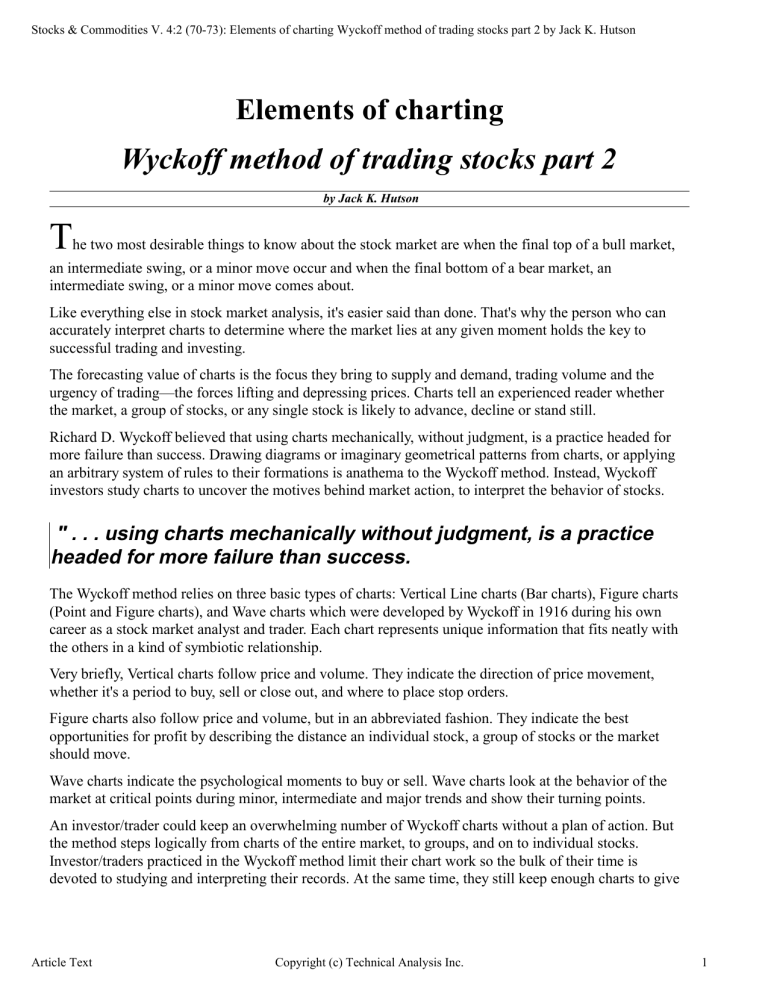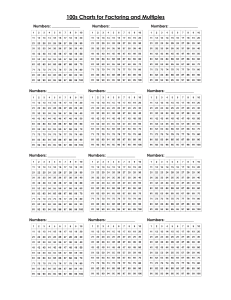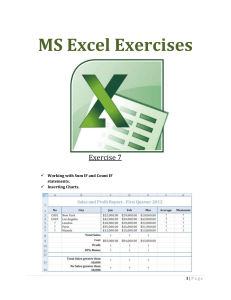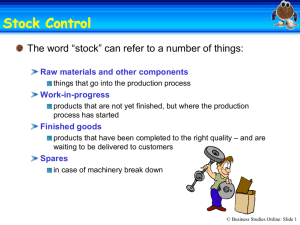
Stocks & Commodities V. 4:2 (70-73): Elements of charting Wyckoff method of trading stocks part 2 by Jack K. Hutson Elements of charting Wyckoff method of trading stocks part 2 by Jack K. Hutson T he two most desirable things to know about the stock market are when the final top of a bull market, an intermediate swing, or a minor move occur and when the final bottom of a bear market, an intermediate swing, or a minor move comes about. Like everything else in stock market analysis, it's easier said than done. That's why the person who can accurately interpret charts to determine where the market lies at any given moment holds the key to successful trading and investing. The forecasting value of charts is the focus they bring to supply and demand, trading volume and the urgency of trading—the forces lifting and depressing prices. Charts tell an experienced reader whether the market, a group of stocks, or any single stock is likely to advance, decline or stand still. Richard D. Wyckoff believed that using charts mechanically, without judgment, is a practice headed for more failure than success. Drawing diagrams or imaginary geometrical patterns from charts, or applying an arbitrary system of rules to their formations is anathema to the Wyckoff method. Instead, Wyckoff investors study charts to uncover the motives behind market action, to interpret the behavior of stocks. " . . . using charts mechanically without judgment, is a practice headed for more failure than success. The Wyckoff method relies on three basic types of charts: Vertical Line charts (Bar charts), Figure charts (Point and Figure charts), and Wave charts which were developed by Wyckoff in 1916 during his own career as a stock market analyst and trader. Each chart represents unique information that fits neatly with the others in a kind of symbiotic relationship. Very briefly, Vertical charts follow price and volume. They indicate the direction of price movement, whether it's a period to buy, sell or close out, and where to place stop orders. Figure charts also follow price and volume, but in an abbreviated fashion. They indicate the best opportunities for profit by describing the distance an individual stock, a group of stocks or the market should move. Wave charts indicate the psychological moments to buy or sell. Wave charts look at the behavior of the market at critical points during minor, intermediate and major trends and show their turning points. An investor/trader could keep an overwhelming number of Wyckoff charts without a plan of action. But the method steps logically from charts of the entire market, to groups, and on to individual stocks. Investor/traders practiced in the Wyckoff method limit their chart work so the bulk of their time is devoted to studying and interpreting their records. At the same time, they still keep enough charts to give Article Text Copyright (c) Technical Analysis Inc. 1 Stocks & Commodities V. 4:2 (70-73): Elements of charting Wyckoff method of trading stocks part 2 by Jack K. Hutson themselves selection and a broad perspective of the trends. An introduction to the Wyckoff method starts with Vertical and Figure charts, which directly supplement each other. Vertical charts describe the direction in which a stock, a group, or the market is headed, while Figure charts indicate just how far they should go. Constructing these charts requires only graph paper and the stock report in the daily newspaper. Vertical Line charts (bar chart) Vertical charts record the daily high, low, and closing prices plus the trading volumes of individual stocks, averages for groups of stocks, or the market's leading composite averages, depending on their intended use. A Vertical chart for an individual stock, for instance, records each day's exact high, low and closing prices, including fractions, and joins them with a vertical line. Beneath the price lines, the day's trading volume sprouts from the bottom of the chart as another vertical line. The price and volume lines show the day's tugging between bears and bulls, while the closing price indicates the result of the day's battle. When the closing prices are joined in a continuous line across the chart, they also indicate the net progress of the market. The price movement in a Vertical chart indicates supply and demand, the points of resistance and support, and the trend, while changes in volume describe the intensity of the trading and the quality of the buying and selling. Together, price and volume signal the direction of coming moves—when a stock is on the springboard (see Holliston Hill, "Chart Congestion Analysis," Technical Analysis of Stocks & Commodities, February 1985, pp. 7-12) and ready to jump, when a move is culminating, and whether this is the phase to buy or sell, go long or go short. A daily Vertical chart is sensitive to the most advantageous conditions for buying and selling, and to turning points. When daily charts are condensed into weekly and monthly charts they visualize long-term trends and long-range moves to help the investor/trader judge the market's present position in relation to ultimate destination. Vertical charts that record the market's leading composite averages are called Trend charts. Two trends should be considered in trading: the immediate trend for active traders looking for profits in small swings, and the intermediate swings of five to 30 points that afford excellent opportunities for all trading and investing. These intermediate swings occur while the market is cycling from the upward trend of a bull market to the downward trend of a bear market and vice versa. It's vital to know whether the intermediate swing is beginning, ending, partially over, or in a period of transition, as well as whether the overall market is on an upswing or downswing. In an upward bull market, most of your trades should be on the long side and, in a declining bear market, orders should be on the short side. Going long in a bull market means that even if your stock declines, the market's upward trend will tend to return a profit if you have patience. If you go long in a bear market and miss the mark, your losses most likely will keep increasing. "It's vital to know ... whether the overall market is on an upswing or a downswing." Article Text Copyright (c) Technical Analysis Inc. 2 Stocks & Commodities V. 4:2 (70-73): Elements of charting Wyckoff method of trading stocks part 2 by Jack K. Hutson A Trend chart of the composite averages is the best way to determine what stage the market is in. It's a large-scale road map to judge the market's present position relative to its ultimate destination. Of course, all stocks don't move up and down together. They do tend to move downward more uniformly in declining markets. But when a declining market is ending, some stocks and some groups will stabilize and head upward before the rest, moving much faster and farther than the average. Determining which groups of stocks show the most promise for profit entails Group charts. These are Vertical charts that record the averages of at least five leading stocks in an industry or a market segment as you've defined it. Group charts point out the industries that promise to improve or deteriorate and cue you to search these groups for individual stocks. A Group chart is constructed by selecting the leading stocks in a group and calculating the averages of their highest, lowest, and closing prices (i.e., add up all the highest prices and divide by the number of stocks to calculate the group's average closing price). Volumes are simply totaled, without dividing or averaging. These average prices and total volume are charted like any other Vertical chart. Some Group charts weight individual issues by the quantity of outstanding shares. The goal is to compare your Group charts with the market activity in your Trend charts and find the groups that are strong when the market is weak or groups that are weak when the market is strong. The reason is simple: In a weak market, buyers obviously have reason to believe they can sell later at a higher price. On the other hand, a group that is exceptionally weak in a strong market indicates that somebody knows something to its disadvantage and is selling out. Whether the selling is out of urgency or profit-taking, the end result will be the same. Figure charts (Point & Figure) Figure charts record only the price movements from one whole number, or figure, to another. They don't recognize fractional price changes. Their value is in estimating the probable extent of supply and demand and the points of resistance and support. Figure charts are used in conjunction with Vertical charts to more accurately map the future of a move. A Vertical chart is like a compass pointing out the direction, while the Figure chart shows how far it should go. Figure charts contain only the amount of detail you want. One-point Figure charts record every full price change—from 57 to 58 to 59. Three-point Figure charts record only three-point changes—from 57 to 60 to 63. Five- and 10-point charts follow the same pattern. The Wyckoff method requires experience with one- and three-point charts. The one-point chart indicates immediate or shorter-swing objectives, while the three-point chart is a guide to general trends and probable objectives of the large swings. Together, one- and three-point Figure charts usually confirm each other, although if they differ markedly, the more conservative indication is chosen. A one-point Figure chart for a stock can be built from Vertical charts or from the daily newspaper listings of opening, highest, lowest, and closing prices. Suppose your stock closed at 50 on Monday. On Tuesday, it opened at 50¾, went as high as 51 7/8, as low as 45¾, and closed at 48¾. Your one-point Figure chart for the two days looks like this: Article Text Copyright (c) Technical Analysis Inc. 3 Stocks & Commodities V. 4:2 (70-73): Elements of charting Wyckoff method of trading stocks part 2 by Jack K. Hutson A three-point Figure chart condenses the one-point chart by discarding all changes of less than three points. In our previous example, the only three-point move occurs between Tuesday's high and Tuesday's low. The three-point chart would look like: The Figure chart's general patterns detect accumulation or distribution, clearly mark lines of support and supply, and identify marking up and marking down periods. " Wyckoff investors study charts to uncover the motives behind market action...." However, the most valuable features of Figure charts are their "horizontal formations," or sideways holding formations, that in many cases will approximate the number of points a single stock, a group of stocks, or a market average should move. In addition, these horizontal formations, or "congestion areas," also help determine when a stock has met opposition and reached the end of its move. So far, we've seen how Vertical and Figure charts show the direction and dimension of a move. In deciding when to act, a Wave chart is the best guide. Wave charts A Wave chart shows the psychological moment to buy or sell. It is the pulse of the market, a condensed picture of every vital development in every stock market session and an invaluable aid in determining the turning points of minor and intermediate swingsÑ frequently days before the popular averages give an indication. Wave charts are graphs of the aggregate price of the five leading stocks of an industry group over the past several months. This group of five is adjusted from time to time so the Wave chart shows the progress of stocks with continuous and real leadership. Every change in the aggregate price throughout the trading Article Text Copyright (c) Technical Analysis Inc. 4 Stocks & Commodities V. 4:2 (70-73): Elements of charting Wyckoff method of trading stocks part 2 by Jack K. Hutson day is plotted, and a complete Wave chart also shows volume and an index of activity, or intensity of trading. We'll get into a complete discussion of Wave charts a little later because mastery of them requires a thorough understanding of other concepts. Chart building is, essentially, a clerical task, but one that can teach important lessons about market behavior. One trap to avoid is devoting more time to constructing charts than to interpreting them. It's a balance that comes with practice. At the start, Wyckoff recommends maintaining Trend charts of the market averages and Group charts of the most important group averages. Then, when the Group charts offer promising opportunities, refer to Figure charts of individual stocks in that group to decide which are in the best position. When you've narrowed your selection to one or two of the best stocks in the group, it's a simple matter to make Vertical charts of those stocks if you've kept a permanent file of the daily newspaper stock reports. An additional tool for gauging where individual stocks are headed is the Position Sheet. A Position Sheet is a daily tally of your interpretation of each stock's Figure and Vertical charts. It summarizes whether you feel a stock is ready for a long or short upward or downward swing or whether there's no definite indication of a move either way. It is a cross check on your chart interpretations and can eventually replace your Group charts and help you judge the trend of the whole market. Just keep in mind that when you're charting, you're dealing with waves. Every swing in the market, no matter how many points it is, consists of numerous buying and selling waves. The waves last just so long as they can attract a following and when that following is exhausted, the wave ends and a contrary wave sets in. It's much like the tide moving to a higher or lower level through a series of surges. The small buy-sell waves during one day are part of larger waves that run several days and eventually turn into 3-to-5-point movements. These, in turn, become the 10-to-20-point waves that build into bear and bull markets. By comparing the duration, the speed and the extent of these various waves, an investor/trader can judge the strength of the bears and the bulls as the market progresses and earn real profitability by working both the up and the down sides of the waves. Figures Copyright (c) Technical Analysis Inc. 5 Stocks & Commodities V. 4:2 (70-73): Elements of charting Wyckoff method of trading stocks part 2 by Jack K. Hutson Figure 1: Figures Copyright (c) Technical Analysis Inc. 6 Stocks & Commodities V. 4:2 (70-73): Elements of charting Wyckoff method of trading stocks part 2 by Jack K. Hutson Figure 2: Figures Copyright (c) Technical Analysis Inc. 7 Stocks & Commodities V. 4:2 (70-73): Elements of charting Wyckoff method of trading stocks part 2 by Jack K. Hutson Figure 3: Figure 4: Figures Copyright (c) Technical Analysis Inc. 8





